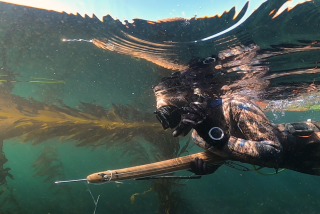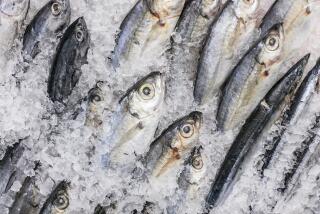Giving Fingerlings a Hand : Group Builds Special Tank to Help Young Seabass Grow to Maturity and Restore Species’ Numbers in Local Waters
- Share via
It’s sort of like a prep school for seabass.
Safe within a submerged fiberglass box, protected from predators by fences and metal screens, fattened on a steady diet of fish chow, several thousand small white seabass will soon spend a few months in King Harbor in Redondo Beach getting ready for life in the ocean.
Except for the cannibalism problem, it sounds like the fish version of the life of Riley--but more on that later.
First some background:
After months of effort and not a few headaches, members of the King Harbor Marlin Club in Redondo Beach this week launched their white seabass “grow-out pen,” part of a regional effort to restore the severely depleted Southern California seabass population to its former teeming glory.
The grow-out pen, a 20-foot- by-8-foot fiberglass box that its builders describe as a “big floating bathtub,” will soon be home to about 3,000 white seabass fingerlings, which will be kept in the box until they get big enough to have a good chance of surviving in the wild.
“We’re just trying to grow little fishes into bigger fishes,” said Chuck Ulrich, 62, who ramrodded the grow-out pen project for the fishing club. “The point is to prove that these fish can be raised in King Harbor in this kind of environment, and I’m convinced that they can.”
For Gary Frantz, 61, another Marlin Club member who designed the grow-out pen, just getting the box safely into the water was a triumph.
“This whole thing is experimental. Nobody knows if any of this is going to work,” Frantz, a mechanical engineer, said shortly before the launching. “I just hope the damn thing doesn’t sink.”
The box didn’t sink after it was lowered into a boat slip at Basin No. 1 at King Harbor Marina--or at least it didn’t sink any lower in the water than it was supposed to. But it remains to be seen if the California seabass population can be restored.
California waters were once full of white seabass, a tasty fish that averages 20 to 40 pounds and can reach 80 pounds. But overfishing and the destruction of habitat over the past few decades has severely depleted the population.
“Back in the 1950s, California sport fishermen were bringing in about 60,000 white seabass a year,” said Mark Drawbridge, a marine biologist at the Hubbs-Sea World Research Institute in San Diego. “But now that’s down to about 2,000 or 3,000 a year.”
In the mid-1980s, marine biologists at the Hubbs-Sea World institute successfully spawned white seabass in an experimental hatchery. Later they began releasing seabass fingerlings into the sea, but the survival rate for fingerlings is low. Researchers finally decided that if they could grow the fingerlings up to about seven or eight inches before releasing them, it would dramatically increase the survival rate.
Drawbridge estimated that while only about 30% of seabass fingerlings survive their first year in the ocean, about 70% of the larger seabass probably will survive the first year. It takes about five years for a white seabass to reach 28 inches, the length at which it is legally catchable.
Last year, the United Anglers of Southern California, which represents about 90,000 California sport fishermen, approached some of its affiliated groups, including the King Harbor Marlin Club, and asked if they’d be willing to operate grow-out pens to help get the seabass up to a survivable size. The Marlin Club, along with fishermen’s groups in Newport Beach, Oxnard, Marina del Rey and Santa Barbara, all agreed to participate. The Oxnard group opened its grow-out pen last year; the Newport Beach facility opened last month.
Although most of the work is done on a volunteer basis, capital and operating costs for the grow-out pen is being paid for with donations and $10,000 in grants from the county and United Anglers. Money from the state Ocean Resources Enhancement and Hatcheries Program, which is funded by a $1 stamp on all California saltwater fishing licenses, is used to operate the hatcheries that will provide the seabass fingerlings.
Ulrich said the Marlin Club’s grow-out pen has cost about $6,000 so far.
While Ulrich spent months getting the necessary permits, Frantz concentrated on the design of the pen.
“There were a lot of things we had to take into account,” Frantz said. “I just hope it all works.”
Predators, such as the sea lions that hang out around King Harbor, had to be kept out with fencing around the pen. Two-legged predators, which Frantz describes as “Some damn guy who might come up with a net and dip them (the bass fingerlings) out for bait,” also had to be guarded against with fencing. Water flow through the pen had to be regulated with a pump, and an automatic feeding machine--the fingerlings will be fed fish food pellets eight times a day--had to be installed.
One problem that is difficult to guard against, however, is the seabass penchant for cannibalism.
“They seem to prefer to eat each other rather than the fish pellets,” Drawbridge pointed out, adding that a seabass can eat any fish that’s one third its own size or smaller. Cannibalism can be minimized by separating the faster-growing fish from the slower-growing ones, and by keeping them well fed. But some cannibalism, he said, is unavoidable.
The first batch of 3,000 two-inch-long seabass fingerlings, which will be provided by the Hubbs-Sea World Research Institute, will be loaded into the pen next month. They will spend about four months in the pen, until they reach seven or eight inches, and then they’ll be released into the harbor. Each will be tagged so that researchers can trace their movements and development. Then another batch of 3,000 fingerlings will be loaded into the pen.
If the program is successful, eventually the King Harbor group and other grow-out facilities hope to raise and release a total of about 450,000 seabass a year, which will be provided by a new hatchery at Carlsbad.
“We think that that should increase the annual seabass catch to about 20,000 a year,” Drawbridge said.
Seabass Portrait Name: White seabass (Atractoscion Attractoscion nobilis) Size: Immature two to four inches; juveniles 24 inches; adults up to five feet Marketing: Very young are silvery, brown or golden; juveniles are silvery gray with series of dark bars on sides; adults are gray-blue, bronze or almost yellow Food: Mobile prey including sardines, mackerel, anchovies, squid Spawn: April through August Life span: 20 years plus Habitat: Varies depending on age. Very young live in drift algae just behind surfline; juveniles occupy bays, shallow coastal waters near rocks or kelp; adults found alone or in schools near reefs, kelp beds; during winter, large adults move into deep water, 120 to 350 feet. Source: California Department of Fish and Game
More to Read
Sign up for Essential California
The most important California stories and recommendations in your inbox every morning.
You may occasionally receive promotional content from the Los Angeles Times.










